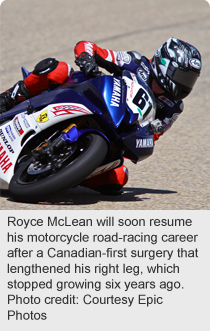
April 29, 2015
Story by Sherri Gallant; photo courtesy Epic Photos
As a five-time Canadian champion motorcycle road-racer, Royce McLean is no stranger to being No. 1.
So he didn’t hesitate when he found out he would be the first person in Canada to undergo a limb-lengthening procedure using a special implant, called the Precice Nail.
“It was a neat experience to see how everything worked – I actually enjoyed it,” says Royce, 20, who put his career on a temporary hold so that Lethbridge orthopedic surgeon Dr. Carrie Kollias could make his legs the same length again.
 “It’s fantastic technology and Royce just happens to be the ideal patient for it.”
“It’s fantastic technology and Royce just happens to be the ideal patient for it.”
More than 1,200 Precice Nail implants have been performed internationally but this is the first time the surgery has been done in Canada.
Royce’s right leg stopped growing after he broke it in a race at age 14. When he had reached his full height of 6-ft.-1, the leg was four centimetres shorter than the left one.
As the years passed, Royce experienced back pain and other ailments. He needed to wear a thick lift on his right shoe and was in danger of developing a curved spine if his condition couldn’t be corrected.
“Royce is a five-time Canadian champion and finished No. 2 in the U.S.,” says his father, Todd McLean. “You can adjust the footpegs on his race bike to different heights, so his shorter leg really didn’t affect his racing, but he couldn’t run or jog anymore. I’d notice it if he was walking around the house in bare feet. He would really hobble and was having trouble with his knee. We noticed him getting fatigued more and you could see when he would stand, he had a real sway in his back.”
Last July during the surgery, Dr. Kollias guided the Precice Nail implant into the hollow centre of Royce’s right femur, entering near the top of the bone.
She cut horizontally through the bone, with the implant holding the femur together from the inside, and anchored the device with screws at the top and bottom.
After the surgery, Royce rested for a week and then started a regimen of adjusting the telescopic ‘nail’ four times a day using a remote-controlled magnetic device.
The magnet turned a screw mechanism in the nail, opening it to a programmed amount – in Royce’s case, a quarter of a millimetre each session, for a daily total of one millimetre. As the cut in the femur widened, new bone cells steadily filled the gap.
“For the first three days when I started the lengthening procedure, I could feel it when I’d first turn the magnet on,” Royce says. “It felt like it was lightly taking the slack out of the bolts, but it didn’t hurt at all.”
The final adjustment was made on Sept. 10 when four centimetres of growth was achieved, equalizing the length in both legs, and by December, the new bone was strong enough for Royce to start putting his weight on it.
“I was really diligent and made sure I did everything I was told to do by Dr. Kollias,” Royce says. “I worked very closely with my physiotherapist, who gave me exercises to do multiple times per day.”
A high level of commitment to keep up with the intensive rehabilitation is a must for patients considering such a procedure.
Dr. Kollias says the surgery cannot be used for young children, but is an option for adolescents and young adults who have significant limb-length discrepancies.
Traditional methods for limb-lengthening involve external fixation of rods or frames screwed through tissue into the bone.
“Royce was highly motivated, he’s young and he’s got good biology,” Dr. Kollias says. “He’s not a 60-year-old smoker. You could cause serious problems such as failure of bone healing for patients if you did this in the wrong person, or if you had a patient who doesn’t have the motivation to do the intensive rehab.”
Dr. Kollias will remove the nail later this year.
As for Royce, his plans are to keep winning.
“I can walk without crutches now and my legs are the same length,” he says. “I am in training to resume racing next year.”